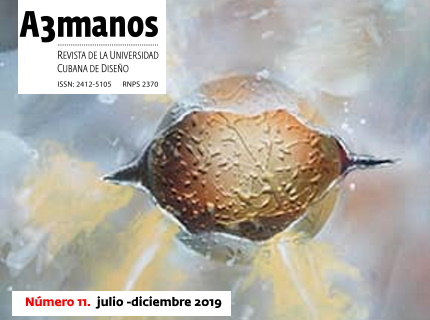The desing in modernity. A creative activity.
##plugins.themes.bootstrap3.article.main##
Abstract
This article presents the main results of the interviews carried out with the selected specialists linked to the design work from their professions, as well as the opinions expressed by the authors themselves regarding hierarchy and demonstrating the integrative approach of this branch of applied knowledge. , especially the industrial one from knowing the new technologies and techniques that are imposed in different fields of science and where design plays an important role as opposed to ideas that partially emphasize the scope of design in society. The main international trends that support the existence of a necessary revolution in the theory and practice of industrial design are presented in the work and within this the mechanic, the partisan role of the design illustrated through the ideological property that reinforces the necessary social edge that involves it with the satisfaction of a human need. The research presented is descriptive and where the main source of information is based on the comments and reflections of the specialists interviewed, as well as using a current bibliography according to the objectives of the work. The results arrived are coherent, pertinent and reflect the current reality that the design is going through today, as opposed to the tendencies of the error of the existence of a quietism in the development of the design.
##plugins.themes.bootstrap3.article.details##

This work is licensed under a Creative Commons Attribution-NonCommercial-ShareAlike 4.0 International License.
- Attribution — You must give appropriate credit , provide a link to the license, and indicate if changes were made . You may do so in any reasonable manner, but not in any way that suggests the licensor endorses you or your use.
- NonCommercial — You may not use the material for commercial purposes .
- No additional restrictions — You may not apply legal terms or technological measures that legally restrict others from doing anything the license permits.
- ShareAlike — If you remix, transform, or build upon the material, you must distribute your contribution under the same license as the original. NOTE: This point applies to numbers 1 to 20 of the magazine with the previous CC-BY-NC-SA 4.0 license. Does not apply to the new CC BY-NC 4.0 license from Volume 11, Number. 21 (2024).
References
Amat Joachin, C. & Pérez Oropesa, J. (2015). Proceso del diseño en la ingeniería. Universidad autónoma de Puebla. Facultad de ciencias de la electrónica. México.
Arana, M.(1998). La Tecnología apropiada: concepción para una cultura. En Tecnología y Sociedad. Editora "Félix Varela", Cuba. (p. 19-30)
Betancourt Herrera, J, L, (2016). Nuevas tecnologías para el diseño. Conferencia para la maestría gestión del diseño, Nuevas tecnologías para el diseño, ISDI, La Habana. Cuba.
Cross, N, (1999). Métodos de diseño. México, Limusa, 1999, ISBN 968-18-5302-4
Cubillas, R. A (2017). Diseño de entornos colaborativos a través de herramientas TICs. ARKA. Revista de Arquitectura NO.3 54-61.
Esparza Ramírez, J, (2012). Factores que influyen en la innovación del producto del diseño (tesis de Maestría). Universidad Autónoma de Nuevo León. México
Fernández, Lucila y otros (2016). Modernidad, identidad y valor social: El diseño en Cuba de 1960-2000.publicacion ISDI. La Habana. Cuba.
Ferrer Gómez, C (2010). Aplicaciones de la Biónica en proyectos de diseño mecánico proyecto de curso. Universidad EACIT, Medellín, Colombia.
Herrera, J, A (2012). Cap. 6 - Las fases de un proyecto. Administración de La Empresa Constructora. Lulu.com. ISBN 978-1300-341-628.
Maldonado, T, (1984), articulo, ULM rivisitato en “rassegne” número 19, 3 de septiembre 1984 p5, Berlín.
Maldonado, T, (1958). Nuevos desarrollos en la industria y en la formación del diseñador de productos, p 31
Rivera Pedraza, J.C & Hernández Ortuño, B (2014). Importancia del análisis del sistema exterior en el modelo de diseño concurrente para el desarrollo de un producto sostenible. Universidad Politécnica de Valencia. España
Rodríguez- Aragón, L. J (2012). Software: sistemas operativos y aplicaciones de la Informática, estadística y Telemática. Universidad Rey Juan Carlos, Madrid. España.
Salinas Flores, Ó, (1992). Historia del diseño industrial. México, Trillas, 1992.
Segrera, A (1999). La visión de la simplificación de la naturaleza en el diseño. En: Ánfora, Vol.17, no.14 (julio 1999 a enero 2000) Colombia.
Torrent, Rosalía, M &, Joan M. (2005), Historia del diseño industrial. Madrid, Cátedra Diseño. Universidad complutense de Madrid. España.
Zaldivar Salazar; M (2018). Relaciones sinérgicas del mantenimiento y la fiabilidad de las maquinas. Monografía, ISDi-UH. La Habana. Cuba
Zaldivar Salazar, M. C (2019). Reflexiones sobre el diseño mecánico en el siglo XXI. Revista A3Manos, Vol. 2 .2019.






















